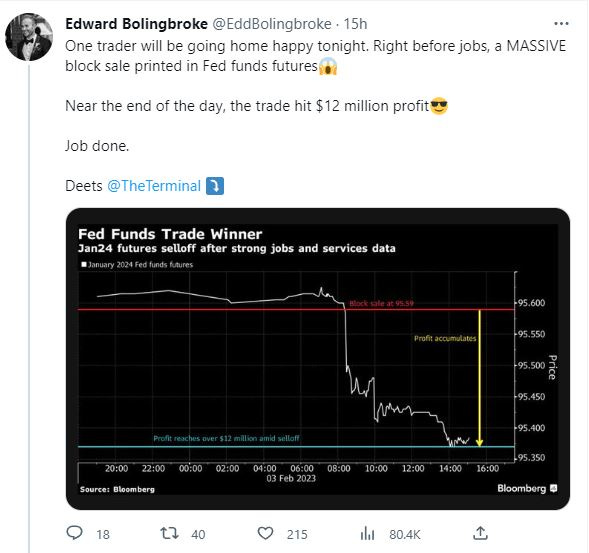WEEK AHEAD
Following last week's FOMC meeting and a data deluge capped off by the blockbuster January jobs report, this week's economic calendar features just a handful of second-tier data points. That being said, Chair Powell's speech at the Economic Club of Washington on Tuesday will kick off a full Fedspeak lineup featuring Vice Chair of Supervision Barr (Tuesday), New York Fed President Williams (Wednesday), Fed Governor Cook (Wednesday), Minneapolis President Kashkari (Wednesday) as well as Fed Governor Waller (Wednesday).
US MARKETS
The US economy added a whopping 517k jobs in January, squaring up to a string of catchy big tech layoff headlines. But fortunately for risk markets, compensation costs have continued to slide. Recall Chair Powell took a somewhat agnostic policy view and implied that the Fed would not push for tighter conditions if spot wage and inflation data continued to improve.
Still, the hiring pick-up suggests the US is hardly in a recession, raising the risk of an extended tightening cycle, which would add an unanticipated headwind to stock valuations and commodity prices that both had expected FED cuts in the later part of 2023.
WINNERS AND LOSERS

ASIA MARKETS
Asia FX took a bit of a beating on Friday, with most regional currencies dropping over 1% as traders were caught flat-footed.
The US nonfarm payrolls report drove US yields higher and equities lower, an unfavorable mix for ASIA FX, particularly given the lower yield levels in this region.
JPY is even worse, with fixed yields and 132 USD/JPY starting to look more likely if US bonds continue to sell off.
After the pullback, the lack of a "carry factor" could be an issue even for those currencies that benefit from China export linkages, perhaps causing investors to look elsewhere in EM, especially if we move back into a pure carry trading environment. After all, you will only get paid big and fast once on the reopening trade.
With the PBoC likely welcoming some currency weakness, we expect little pushback on the FIX.
Outside of the NFP scorcher slamming regional equities after local currencies took it on the chin, reports that President Biden is considering entirely banning US exports to Huawei impacted sentiment. However, US secretary of state Antony Blinken will meet President Xi in Beijing this week and should be the focus.
FOREX MARKETS
Since we are amidst a broadly procyclical environment, it is still an untoward macro mix for the US dollar. However, now that the FX complex has been dished out another plate of Fed policy uncertainly, and since revenge is a dish best served cold, FX traders might let the Fedspeak payroll response play out this week before adding to or re-entering short dollar positions.
GOLD MARKETS
Gold bugs will call for 2nd inflation wave after the jobs beat as a sure-fire signal gold is going higher. But after getting hit with the silly stick on Friday, speculators will be challenged to get back into the saddle quickly, however longer term holders and EM central banks, who are relatively price agnostic, will view this as another buying opportunity given the geopolitical uncertainty and ongoing dollar diversification under the hood.
While calling me skeptical that inflation will fall in a tidy fashion, I'm not sure that consumer prices will be a crucial driver of gold; in the same light, it wasn't much of a driver in this current upswing Plus, US inflation could still drop much further even as China reopens. The anticipated rise in oil prices and bump in global growth on the China bounce will likely be offset to a large degree by the supply chain normalization process, which will be a crucial driver of disinflation in 2023.
Not a great idea to jump the shark on one NFP report.
Gold fits into the category "you get the US dollar call right; you get everything right."
OIL MARKETS
Despite clear signs that China's mobility is on the recovery track and the EU's ban on Russian crude oil product imports taking effect Sunday (we think at the time of writing), oil prices were down an eyewatering $7.00 per barrel last week as a consequence of enormous inventory builds in US crude oil and products and fewer imports into China.
In addition, the mix of higher jobs and lower compensation (less inflationary) was perceived as a toxic brew for oil markets as too much of a good thing (Jobs) could provide unequivocal evidence for the FED to continue driving growth, perhaps even more aggressively below-trend by extending the policy cycle.
Now that we have breached the Brent $80-a-barrel mark, which was thought to be a tough nut to crack, there could be room for the market to clear out more wildly if someone bangs the open. However, the Saudis will not let Brent trade below or even hang around $75 per barrel, so we anticipate a tacit production response per OPEC PUT.
